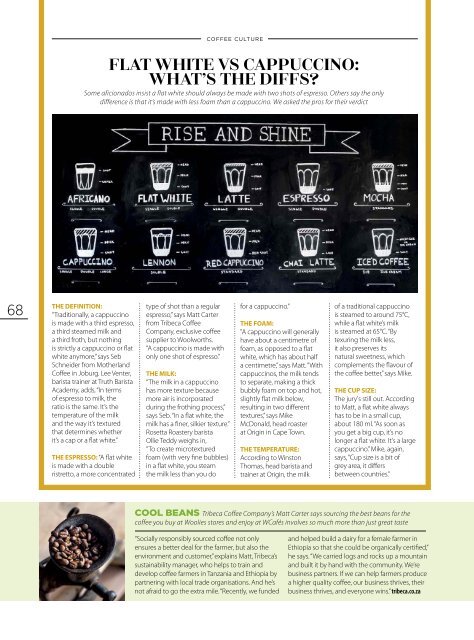Woolworths_Taste_July_2017
Create successful ePaper yourself
Turn your PDF publications into a flip-book with our unique Google optimized e-Paper software.
COFFEE CULTURE<br />
FLAT WHITE VS CAPPUCCINO:<br />
WHAT’S THE DIFFS?<br />
Some aficionados insist a flat white should always be made with two shots of espresso. Others say the only<br />
difference is that it’s made with less foam than a cappuccino. We asked the pros for their verdict<br />
68<br />
THE DEFINITION:<br />
“Traditionally, a cappuccino<br />
is made with a third espresso,<br />
a third steamed milk and<br />
a third froth, but nothing<br />
is strictly a cappuccino or flat<br />
white anymore,” says Seb<br />
Schneider from Motherland<br />
Coffee in Joburg. Lee Venter,<br />
barista trainer at Truth Barista<br />
Academy, adds, “In terms<br />
of espresso to milk, the<br />
ratio is the same. It’s the<br />
temperature of the milk<br />
and the way it’s textured<br />
that determines whether<br />
it’s a cap or a flat white.”<br />
THE ESPRESSO: “A flat white<br />
is made with a double<br />
ristretto, a more concentrated<br />
type of shot than a regular<br />
espresso,” says Matt Carter<br />
from Tribeca Coffee<br />
Company, exclusive coffee<br />
supplier to <strong>Woolworths</strong>.<br />
“A cappuccino is made with<br />
only one shot of espresso.”<br />
THE MILK:<br />
“The milk in a cappuccino<br />
has more texture because<br />
more air is incorporated<br />
during the frothing process,”<br />
says Seb. “In a flat white, the<br />
milk has a finer, silkier texture.”<br />
Rosetta Roastery barista<br />
Ollie Teddy weighs in,<br />
“To create microtextured<br />
foam (with very fine bubbles)<br />
in a flat white, you steam<br />
the milk less than you do<br />
for a cappuccino.”<br />
THE FOAM:<br />
"A cappuccino will generally<br />
have about a centimetre of<br />
foam, as opposed to a flat<br />
white, which has about half<br />
a centimetre,” says Matt. “With<br />
cappuccinos, the milk tends<br />
to separate, making a thick<br />
bubbly foam on top and hot,<br />
slightly flat milk below,<br />
resulting in two different<br />
textures,” says Mike<br />
McDonald, head roaster<br />
at Origin in Cape Town.<br />
THE TEMPERATURE:<br />
According to Winston<br />
Thomas, head barista and<br />
trainer at Origin, the milk<br />
of a traditional cappuccino<br />
is steamed to around 75°C,<br />
while a flat white’s milk<br />
is steamed at 65°C. “By<br />
texuring the milk less,<br />
it also preserves its<br />
natural sweetness, which<br />
complements the flavour of<br />
the coffee better,” says Mike.<br />
THE CUP SIZE:<br />
The jury's still out. According<br />
to Matt, a flat white always<br />
has to be in a small cup,<br />
about 180 ml. “As soon as<br />
you get a big cup, it’s no<br />
longer a flat white. It's a large<br />
cappuccino.” Mike, again,<br />
says, “Cup size is a bit of<br />
grey area, it differs<br />
between countries.”<br />
COOL BEANS Tribeca Coffee Company’s Matt Carter says sourcing the best beans for the<br />
coffee you buy at Woolies stores and enjoy at WCafés involves so much more than just great taste<br />
“Socially responsibly sourced coffee not only<br />
ensures a better deal for the farmer, but also the<br />
environment and customer,” explains Matt, Tribeca’s<br />
sustainability manager, who helps to train and<br />
develop coffee farmers in Tanzania and Ethiopia by<br />
partnering with local trade organisations. And he’s<br />
not afraid to go the extra mile. “Recently, we funded<br />
and helped build a dairy for a female farmer in<br />
Ethiopia so that she could be organically certified,”<br />
he says. “We carried logs and rocks up a mountain<br />
and built it by hand with the community. We’re<br />
business partners. If we can help farmers produce<br />
a higher quality coffee, our business thrives, their<br />
business thrives, and everyone wins.” tribeca.co.za

















